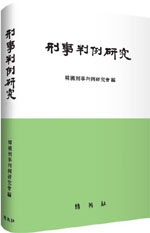- 영문명
- A study on new method of decision about admissibility of digital evidence
- 발행기관
- 한국형사판례연구회
- 저자명
- 김영기(Kim, Young-Ki)
- 간행물 정보
- 『형사판례연구』형사판례연구 제19권, 509~539쪽, 전체 31쪽
- 주제분류
- 법학 > 법학
- 파일형태
- 발행일자
- 2011.06.30

국문 초록
영문 초록
It is defined that digital evidence is all valuable information as evidence that is preserved and delivered in digital form, the salient traits of its character is independent from a storage, invisible, unreadable etc., it must be solved authenticity, reliability, best evidence for the purpose of its admissibility. In our criminal procedure law, the evidence is classified into two types, statements and objects, objects as evidence are composed of documents and things, it could be included statements by a person or not in documents as evidence. In essence digital evidence is regarded as documents evidence so hearsay-rule is applicable to it. To acquire admissibility of digital evidence made by a person it is important that the person acknowledges his digitals documents produced by him-self according to the criminal procedure law art. 313① in a court but the opinion that only the acknowledgement by a writer can give admissibility of digital evidence is very dangerous in criminal procedure because it may make valuable evidences useless things. In the revised criminal procedure law new solution is imposed in it. Even though a person deny its contents in a report said by him-self for example “I didn’t talk like that in a report”, prosecutor could prove that a report made by a investigator is credible and exact in the objective way including recording video-tape etc., the admissibility of a report evidence can be achieved recognition. This revised purpose must be regraded as a new basis in evidence law totally, even if a person deny his digital document made by him-self for example “I didn t make digital document like that”, prosecutor could prove that a digital document is made by him-self in the objective way including analysis meta-data etc., “it is you who made this digital document”, the admissibility of a digital document evidence could be achieved recognition. if to prove who made a digital document evidence end in failure, its admissibility have to be reviewed again according to criminal procedure law art. 315, valuable digital evidence must not go into the dumper easily. Anyone talking about evidence in criminal procedure cannot help but mention digital information that is essential in it by progress of scientific technology. Much to our regret, there is not at all rule for the purpose of admissibility of digital evidence in present criminal procedure law, as a result many opinions and judicial decisions consider requisites of admissibility of digital document as one of admissibility of non-digital document but an intrinsic attribute of digital evidence is profoundly different from one of traditional evidence. Ultimately I think that criminal procedure law must be revised referring to foreign country’ law to acquire admissibility of digital evidence although a person deny a digital document that is made by him-self, if prosecutor could be successful in pr○○f, “it is written by him-self”, in other words witness or suspect, the digital evidence shall be useful. I wish to be collected g○○d thoughts to prevent that valuable digital evidence may be discharged by only one statement of a wicked-person.
목차
Ⅰ. 대상판결
Ⅱ. 논의의 필요성
Ⅲ. 디지털 증거의 무결성, 신뢰성, 원본성
Ⅳ. 디지털 증거의 증거능력 부여 요건
Ⅴ. 형사소송법 개정을 통한 문제 해결
Ⅵ. 결론
키워드
새로운 디지털 증거 증거능력 부여 방안
무결성
신뢰성
원본증거성
증언
증거물
서류
물건
전문법칙
객관적 방법에 의한 형식적 진정성립 증명
new method of decision about admissibility of digital evidence
authenticity
reliability
best evidence
statements
objects
documents
things
hearsay-rule
the acknowledgement by a writer
the objective way including analysis meta-data etc
해당간행물 수록 논문
참고문헌
최근 이용한 논문
교보eBook 첫 방문을 환영 합니다!

신규가입 혜택 지급이 완료 되었습니다.
바로 사용 가능한 교보e캐시 1,000원 (유효기간 7일)
지금 바로 교보eBook의 다양한 콘텐츠를 이용해 보세요!


